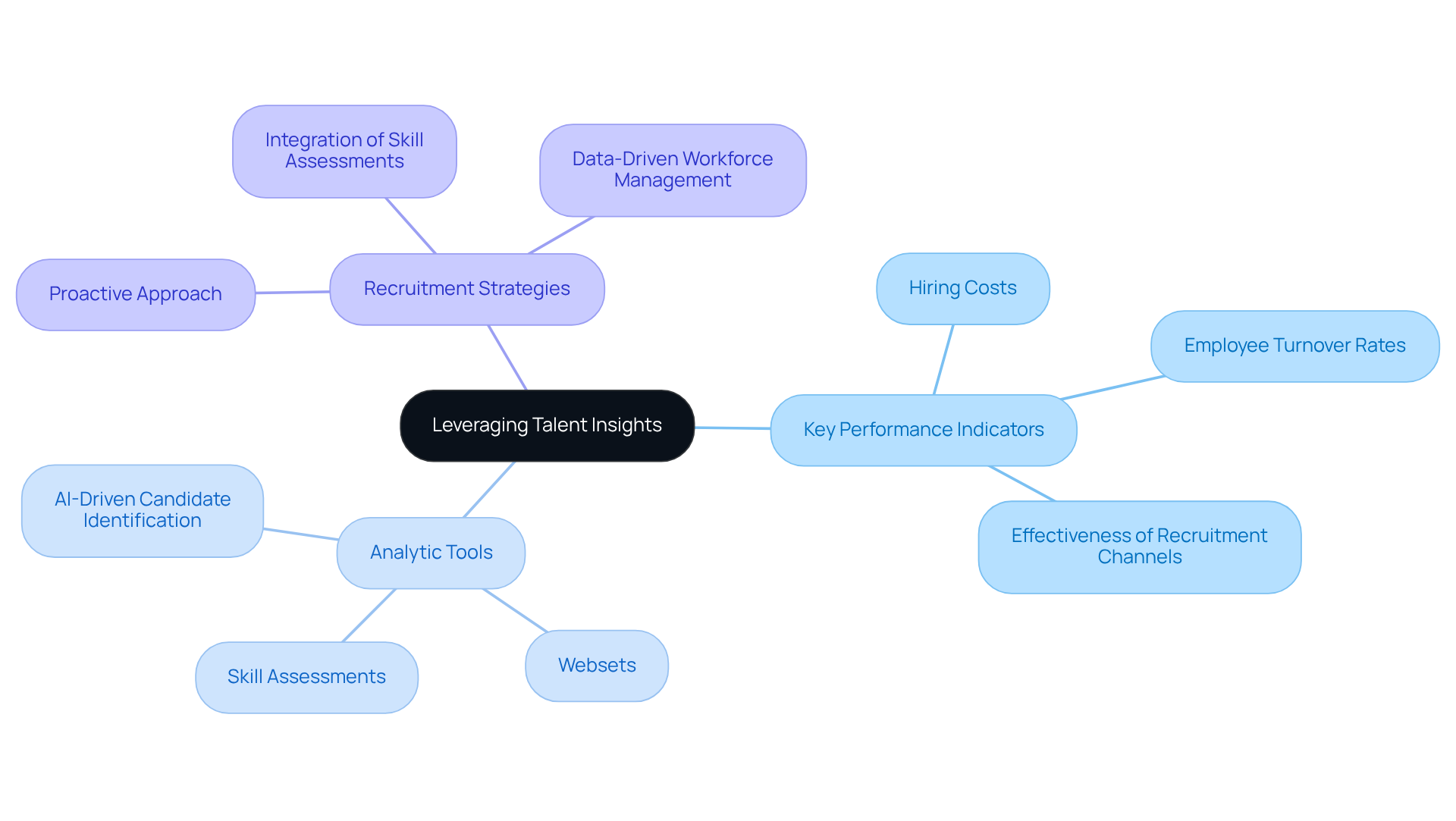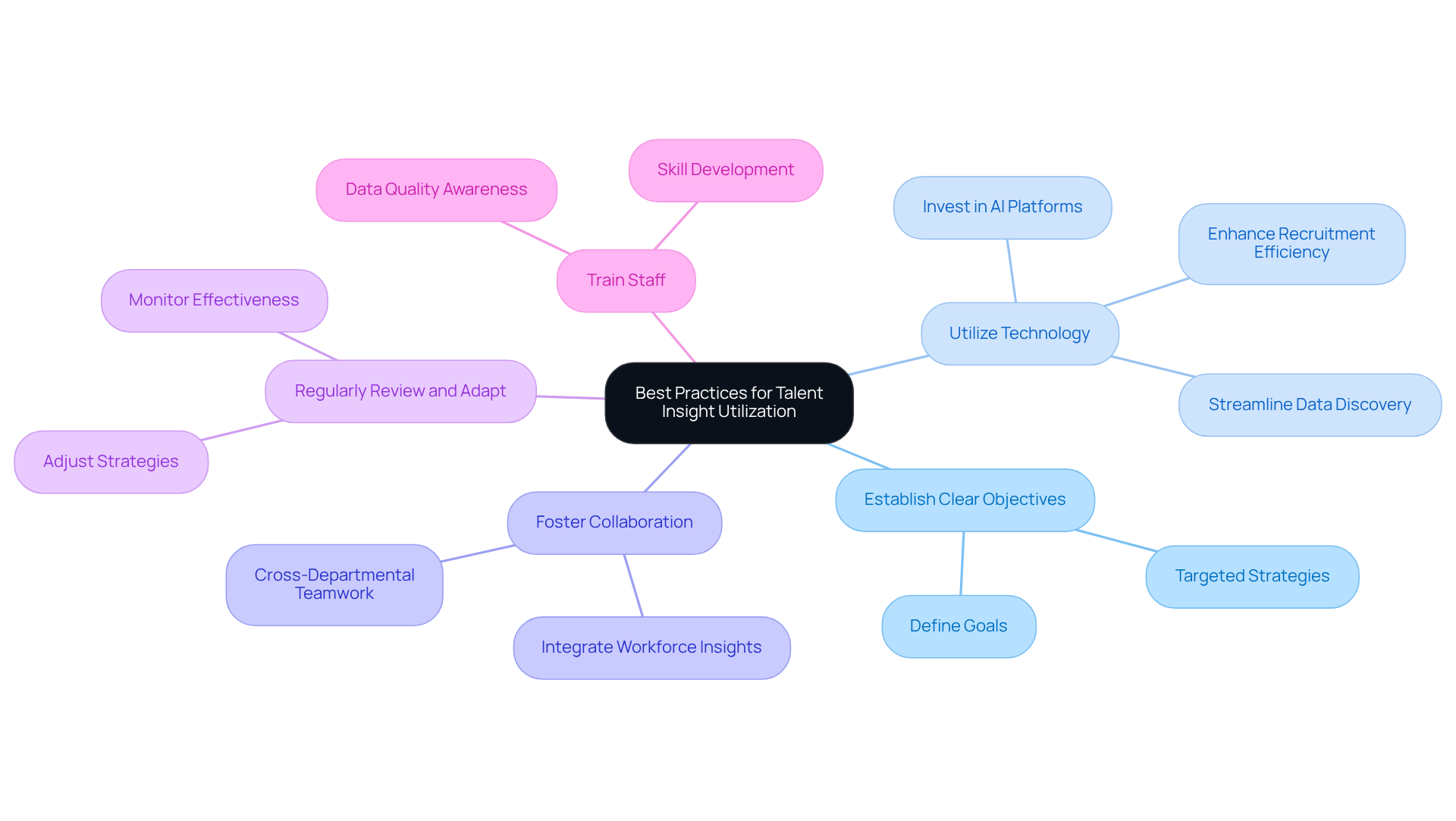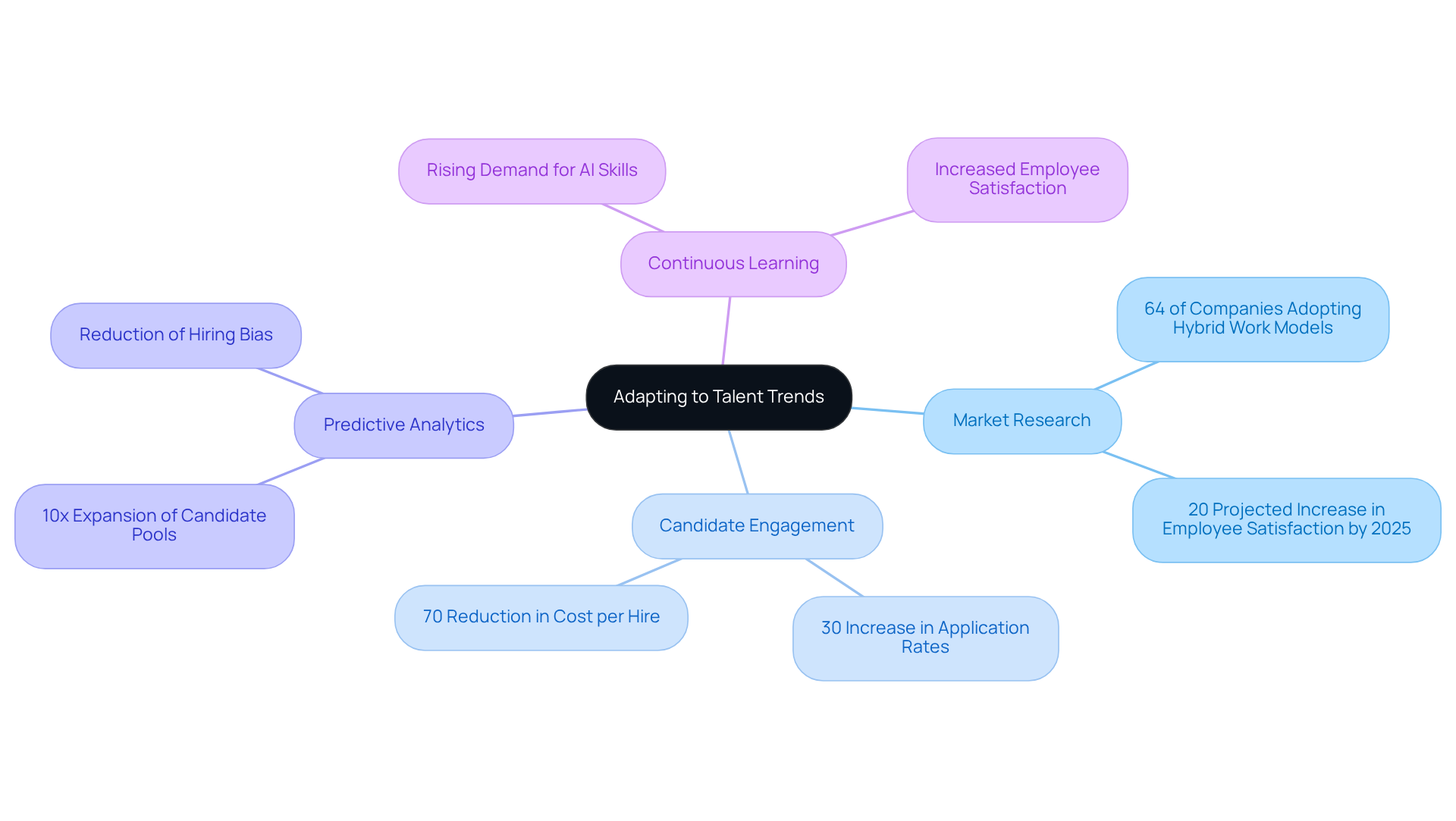Overview
Maximizing talent insights is essential for achieving success in private markets. By implementing data-driven strategies for recruitment and workforce management, organizations can enhance their competitive advantage. Best practices include:
- Leveraging AI tools for candidate identification
- Fostering collaboration across departments
- Adapting to evolving market trends
These strategies empower organizations to make informed decisions, ultimately driving success in a competitive landscape.
Introduction
Unlocking the potential of talent insights stands as a pivotal strategy for organizations navigating the complexities of private markets. By harnessing data-driven analytics, companies can enhance their recruitment processes and align their workforce strategies with broader business goals. Yet, as the landscape evolves, a pressing question arises: how can firms effectively leverage these insights to stay ahead of market trends and ensure sustainable success? This inquiry is not merely academic; it is essential for organizations aiming to thrive in a competitive environment.
Leverage Talent Insights for Strategic Value Creation
To unlock the strategic value of skill insights, organizations must establish a comprehensive framework for data collection and analysis. This begins with identifying key performance indicators (KPIs) that align with business goals—think hiring costs, employee turnover rates, and the effectiveness of recruitment channels. By leveraging sophisticated analytic tools like AI-driven candidate identification and assessment, companies can cultivate a thorough understanding of their workforce environment. This empowers them to make informed decisions regarding recruitment, retention, and development plans.
Consider Websets, which enables recruiters to filter candidates by skills, experience, and location. It provides LinkedIn profiles, emails, and previous work experience, facilitating the search for the perfect match for open positions. Such a proactive approach not only fortifies the firm's competitive advantage but also ensures that investments are aligned with market demands. Furthermore, integrating skill assessments into the investment thesis allows firms to evaluate the potential of portfolio companies, fostering more strategic acquisitions and collaborations.
As the private markets sector anticipates employee turnover rates to remain a critical focus in 2025, the importance of data-driven workforce management strategies cannot be overstated. Organizations must act now to and position themselves for success.

Implement Best Practices for Talent Insight Utilization
To successfully apply skill observations, organizations must adopt essential best practices.
- Establish Clear Objectives: Clearly defining goals using talent insights for private markets—such as improving recruitment efficiency or enhancing employee engagement—enables targeted strategies that yield measurable results.
- Utilize Technology: Investing in AI-driven platforms like Websets streamlines data discovery and provides enriched insights into potential candidates and market trends. Websets' advanced , featuring tools like the Research Agentic API, is specifically designed for complex queries. This allows entities to uncover unique and niche results that traditional methods may overlook. Notably, AI tools have been shown to significantly improve recruitment efficiency; organizations leveraging recruitment analytics are twice as likely to enhance their hiring outcomes compared to traditional methods. Furthermore, Websets offers flexible, high-capacity rate limits and premium support tailored for enterprise needs, ensuring effective scaling of lead generation and recruitment efforts by leveraging talent insights for private markets.
- Foster Collaboration: Promoting cross-departmental teamwork among HR, finance, and operations ensures that workforce insights are integrated into all business aspects. This comprehensive approach improves decision-making and aligns workforce plans with organizational objectives.
- Regularly Review and Adapt: Continuously monitoring the effectiveness of workforce strategies is crucial, along with a willingness to adjust based on changing market conditions and internal feedback. For instance, firms may discover that certain recruitment channels yield higher-quality candidates, prompting a reallocation of resources.
- Train Staff: Providing team members with the skills to understand and respond to personnel data ensures the entity can react promptly to new information. Training enhances the ability to leverage AI-driven analytics effectively, ultimately leading to improved hiring decisions and reduced turnover. Moreover, entities should remain vigilant against common pitfalls, such as ensuring data quality and reliability, to prevent errors in their implementation of personnel insights.

Adapt to Evolving Talent Trends and Market Dynamics
Organizations must remain vigilant and adaptable to the ever-evolving workforce trends and market dynamics. This can be achieved through several key strategies:
- Conducting Regular Market Research: Staying informed about industry trends—such as shifts in candidate expectations and emerging skills—is crucial. Notably, 64% of companies worldwide are embracing hybrid work models, necessitating adjustments in recruitment approaches to attract top professionals in this new landscape. Moreover, organizations adopting hybrid models are projected to experience a 20% increase in employee satisfaction and engagement by late 2025.
- Engaging with Candidate Pools: Establishing connections with prospective applicants before job openings allows organizations to access expertise swiftly when needed. Companies that prioritize candidate experience see a 30% increase in application rates and a 70% reduction in cost per hire, underscoring the importance of proactive engagement.
- Utilizing Predictive Analytics: Leveraging to forecast workforce requirements based on market trends and business growth projections enables firms to anticipate changes effectively. Organizations employing data-driven hiring strategies can expand their candidate pools by up to 10 times, enhancing the quality of hires and reducing hiring bias.
- Encouraging a Culture of Continuous Learning: Fostering an environment where employees are encouraged to upskill and adapt to new technologies not only enhances employee satisfaction but also ensures competitiveness. As AI technology advances, the demand for workers skilled in managing and collaborating with AI systems is expected to rise, making continuous learning indispensable.
By embracing these strategies, firms can effectively navigate the complexities of the talent market using talent insights for private markets to position themselves for long-term success.

Conclusion
Maximizing talent insights is not merely beneficial; it is essential for organizations aiming to excel in the competitive landscape of private markets. By establishing a robust framework for data collection and analysis, companies can harness skill insights that drive strategic value creation. This approach enhances recruitment and retention strategies while aligning workforce capabilities with organizational goals, ensuring that businesses are equipped to respond effectively to market demands.
The arguments presented underscore the necessity of:
- Setting clear objectives
- Leveraging advanced technology
- Fostering collaboration
- Cultivating a culture of continuous learning
Organizations that actively engage with candidate pools, utilize predictive analytics, and adapt to evolving workforce trends position themselves to significantly enhance their hiring outcomes. The integration of AI-driven tools like Websets streamlines the recruitment process, allowing for a more strategic approach to talent management.
Ultimately, the effective leverage of talent insights will be a defining factor for the success of private market firms in 2025 and beyond. Embracing these practices not only prepares organizations to meet the challenges of a dynamic environment but also empowers them to create a sustainable competitive advantage. By prioritizing talent insights, businesses can navigate market complexities and secure their future success.
Frequently Asked Questions
What is the first step in leveraging talent insights for strategic value creation?
The first step is to establish a comprehensive framework for data collection and analysis, starting with identifying key performance indicators (KPIs) that align with business goals.
What are some examples of key performance indicators (KPIs) organizations should focus on?
Examples of KPIs include hiring costs, employee turnover rates, and the effectiveness of recruitment channels.
How can organizations enhance their understanding of the workforce environment?
Organizations can enhance their understanding by leveraging sophisticated analytic tools, such as AI-driven candidate identification and assessment.
What is the role of Websets in the recruitment process?
Websets enables recruiters to filter candidates by skills, experience, and location, providing LinkedIn profiles, emails, and previous work experience to facilitate the search for suitable candidates.
How does a proactive approach to recruitment benefit organizations?
A proactive approach fortifies the firm's competitive advantage and ensures that investments are aligned with market demands.
Why is integrating skill assessments into the investment thesis important?
Integrating skill assessments allows firms to evaluate the potential of portfolio companies, fostering more strategic acquisitions and collaborations.
What is expected regarding employee turnover rates in the private markets sector by 2025?
Employee turnover rates are anticipated to remain a critical focus in the private markets sector by 2025.
Why is it important for organizations to harness data-driven workforce management strategies?
It is important to harness these insights to position themselves for success in a competitive environment.




